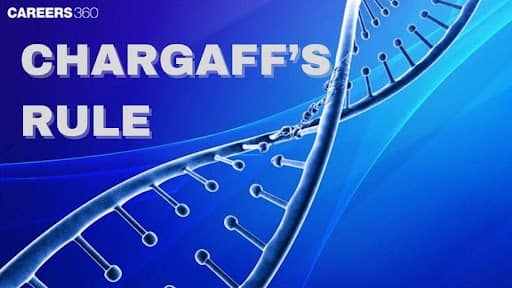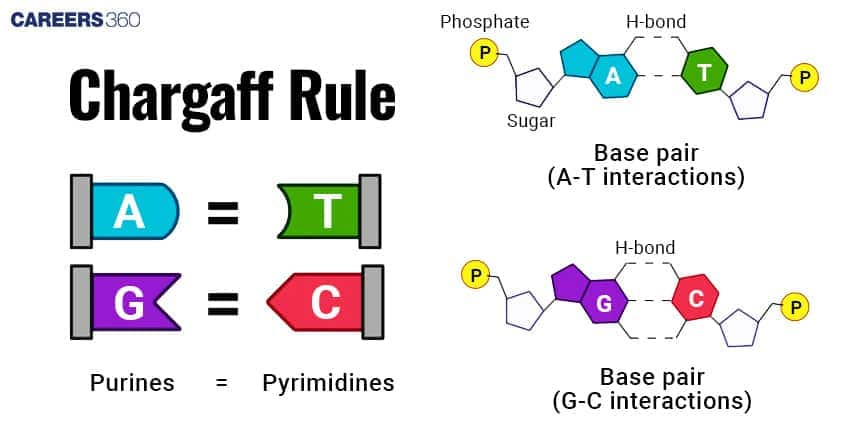Chargaff Rule: Overview, Discoveries & Rules
In the late 1940s, Erwin Chargaff discovered that in a DNA sample, the amount of adenine (A) is always equal to thymine (T) and the amount of guanine (G) equals cytosine (C). This observation is known as Chargaff’s Rule. Based on this concept Watson and Crick and they proposed the double-helix model. It showed that base pairing is specific and consistent, which helps to explain how genetic information is passed from one generation to the next. In the study of the molecular basis of inheritance, it is important in understanding the structure and function of DNA.
- What Is The Chargaff Rule?
- Chargaff's First Rule
- Chargaff's Second Rule
- Diagram: Chargaff’s Rule
- Application Of Chargaff's Rules
- Recommended Video On Chargaff's Rule
- MCQs on Chargaff’s Rule

The fixed ratios of nitrogenous bases ensure that the DNA can pass genetic information easily. This accurate base pairing mechanism is essential for key processes in gene expression. The processes include DNA replication, transcription, and the synthesis of proteins, the central dogma of molecular biology.
What Is The Chargaff Rule?
Chargaff's rule is an important concept of molecular biology given by Erwin Chargaff, an Austrian biochemist in the mid-20th century. He stated that in a DNA molecule, the amount of A (adenine) is equivalent to T (thymine), and G (guanine) is equivalent to C (cytosine). This means that A always pairs with T, and G always pairs with C. This complementary base pairing helped to discover the DNA double helix.
Chargaff’s experiments were crucial in understanding the structure and function of DNA. His work came along when most of the scientists were trying to decode the molecular structure of DNA. Chargaff carefully analyzed DNA samples from different species. These results indicated that the proportion between A and T, and G and C is always equal in a species, but varies between different species. This provided strong evidence for the base-pairing mechanism. Chargaff's rules served as the basis for Watson and Crick to discover the double helix model, which eventually changed the perception of genetics.
Chargaff's First Rule
Chargaff’s First Rule is also known as the base-pairing rule. It states that in DNA, adenine-thymine (A-T) and guanine-cytosine (G-C) make pairs with each other.
A always pairs with T through two hydrogen bonds.
G always pairs with C through three hydrogen bonds.
These hydrogen bonds help to stabilize the double helix structure of DNA. The total amount of purines (A + G) is equal to the total amount of pyrimidines (T + G). This keeps the DNA structurally balanced. Chargaff’s experiments showed that these ratios were the same in organisms that have double-stranded DNA as their genetic material. This was later confirmed by the model of DNA proposed by Watson and Crick.
Chargaff's Second Rule
Chargaff's second rule explains that within a single species, the ratio of adenine to thymine and the guanine to cytosine remains constant. However, the ratio can greatly differ between species. For example, the DNA of humans has a distinct A/T and G/C ratio compared to DNA of bacteria. Changaff's second rule supports the double helix model. The constant ratio in all species guarantees that DNA maintains the helical shape and allows it to copy during cell division.
This rule highlights two key points:
Consistency within species ensures accurate DNA replication and inheritance.
Variations between species show differences in the genetic code, which helps in identifying evolutionary relationships.
Diagram: Chargaff’s Rule
To understand Chargaff’s rule, a diagram can help show how nitrogenous bases pair. This is crucial for the stability of double helix and accurate transfer of genetic information. The diagram below illustrates the base pairing and their complementary relationship in DNA.
Application Of Chargaff's Rules
Chargaff’s rules played a key role in helping Watson and Crick to discover the structure of DNA as a double helix. The specific base pairing explained how two DNA strands are connected. This also showed that the DNA is antiparallel and it is held together by hydrogen bonds.
In modern genetic research, Chargaff's rules have multiple applications, especially in DNA sequencing and genomics.The predictable base pairing led scientists to sequence DNA and read genetic information accurately. These rules are also important in forensic science, as everyone has a unique sequence of DNA. Moreover, through ancestry tracing, it is possible to find the genetic relationship between individuals and populations. The knowledge of these rules has led to advances in genetic engineering, biotechnology, and medicine.
The significant contributions of Erwin Chargaff in the field of molecular biology have a lasting impact on an understanding of DNA. Chargaff's rules formed the basis for the double helix structure. The clear explanation of specific base pairing and same base pair ratios, he helped in the understanding of the replication of DNA, genetic inheritance, and molecular explanation of the various aspects of life. His work continues to influence current scientific research and highlights the importance of his discoveries in genetics.
Recommended Video On Chargaff's Rule
MCQs on Chargaff’s Rule
Q1. A segment of DNA has 120 adenine and 120 cytosine bases. The total number of nucleotides present in the segment is
60
120
240
480
Correct Answer: 4) 480
Explanation:
To determine the DNA segment's nucleotide count, we apply Chargaff's principle:
1. Adenine (A) to Thymine (T) equality.
2. Cytosine (C) to Guanine (G) equivalence.
Given data:
- A = 120
- C = 120
Using Chargaff's rule:
- A = T (120 T bases)
- C = G (120 G bases)
Now, calculate the total nucleotides:
Total = A + T + C + G
Total = 120 + 120 + 120 + 120
Total = 480 nucleotides
Hence, the correct answer is option 4) 480.
Q2. In DNA if the percentage of Adenine is 30 then what is the percentage of Cytosine?
30
60
20
40
Correct Answer: 3) 20
Explanation:
As we know, the total amount of adenine released is equal to the total amount of thymine. Similarly, the total amount of cytosine released is equal to the total amount of guanine.
The base ratio A/T = 1 and C/G = 1.
So, A/T = C/G = 1, So, A + G = T + C
Adenine is 30%. Hence Thymine = 30%. Thus Purine is 60%.
Pyrimidine = 100 - 60 = 40 . Thus Cytosine = Guanine = 20%
Hence, the correct answer is option 3) 20.
Q3. Which one of the following is not applicable to RNA?
5' phosphoryl and 3' hydroxyl ends
Chargaff 's rule
Heterocyclic nitrogenous bases
Complementary base pairing
Correct answer: 2) Chargaff’s Rule
Explanation:
Chargaff's rules state that DNA from any cell of all organisms should have a 1:1 ratio (base Pair Rule) of pyrimidine and purine bases and, more specifically, that the amount of guanine should be equal to cytosine and the amount of adenine should be equaled to thymine.
Hence, the correct answer is option 2) Chargaff’s Rule.
Also Read:
Frequently Asked Questions (FAQs)
Chargaff’s rule states that in DNA, the amount of adenine (A) is equal to thymine (T), and guanine (G) is equal to the cytosine (C).
It helped in understanding the base-pairing mechanism of DNA. It laid the foundation in discovering DNA double helix structure.
Chargaff’s rules were discovered in the late 1940s and early 1950s.
The first rule states that the amount of A equals T and the amount of G equals C in DNA.
In humans, guanine makes about 20-21% of the total bases. According to Chargaff’s rule, cytosine is 20-21%, and adenine and thymine is 30-31%.
Also Read
06 Aug'25 01:27 AM
26 Jul'25 01:17 PM
26 Jul'25 01:05 PM
26 Jul'25 12:30 PM
26 Jul'25 12:08 PM
25 Jul'25 06:40 PM
25 Jul'25 01:12 PM
25 Jul'25 01:04 PM
